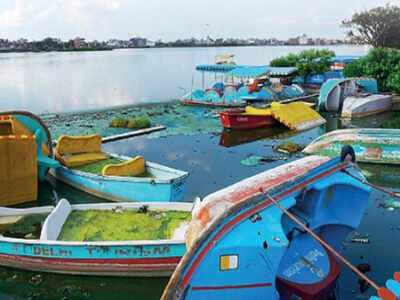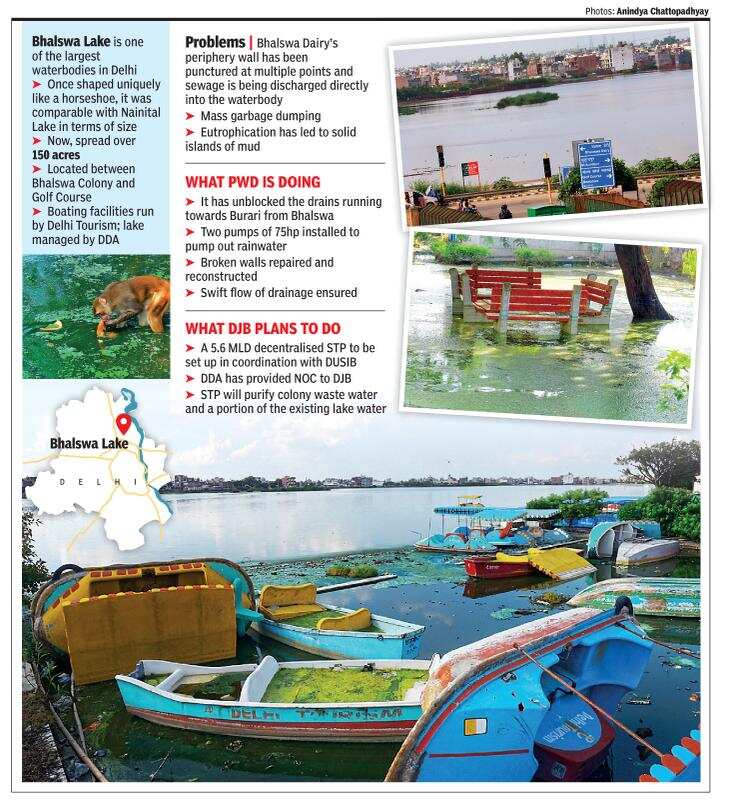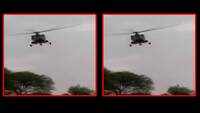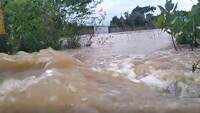
NEW DELHI: Once shaped uniquely like a horseshoe, this waterbody was as big as the touristy Nainital lake. But over decades, Bhalswa lake has lost out to the sanitary landfill and dairy colonies and ceded its respectful size. Dumping of garbage and livestock excreta into the lake has been killing it fast, till now.
The Public Works Department has now started work on the overhaul of the drainage system at the waterbody near Jahangirpuri in northwest Delhi. This is meant to prevent animal dung and sewage from entering the water. At the same time, Delhi Jal Board will set up a wastewater treatment plant to recharge and replenish the dying 150-acre lake.

Tracing the genesis of Bhalswa lake’s woes, a PWD official involved in the restoration project, said that when the parallel ring road was being constructed around four years ago, the Bhalswa drain was blocked. After completion of the work, the civic agencies forgot to unblock the drain. When water and waste accumulated in the colonies and posed a threat to health, the frustrated residents broke the walls of the Bhalswa freshwater lake, and soon turned it into a sludge-filled sewage pit.
TOI found that drains from the dairies nearby had been punctured at numerous places, and sewage and dung discharged directly into the waterbody. Garbage dumping and eutrophication have created islands of mud and thrash, in size up to half of the lake’s width along Outer Ring Road.
For temporary respite, PWD has set up two 75hp pumps that will divert the water and sewage from the area and prevent accumulation. However, for the long term, the agencies are unblocking the drains. Working without a budget and “using only our maintenance funds”, PWD has formed a team to keep tabs on what is happening around the lake and pinpoint the source of problems.
Bhalswa lake historically fell on the northern Yamuna floodplain and was a major source of water for the area. But an embankment built in 1964 cut off the lake’s water supply. The horseshoe lake is said to have formed when the Yamuna changed course, leaving behind a truncated looped portion.
Indian National Trust for Art and Cultural Heritage had come up with a plan to manage the lake, but it was never implemented. Last year, DDA, PWD and DJB carried out a joint survey of Bhalswa lake aiming to revive an old proposal for developing the area into an ecotourism spot. According to the proposal, the site would include facilities for boating and angling and allow space for picnics and a decorative water fountain, according to PWD officials.
Ankit Srivastava, technical advisor to DJB, disclosed that the water utility had written to PWD to start the work on repairing the drainage system. “DUSIB and DJB have jointly planned a scheme in which a decentralised sewage treatment plant with a purification capacity for 5.6 million litres will be set up on land belonging to DUSIB,” said Srivastava.
Srivastava also said that DJB was aware that the wall of the lake was frequently broken into and cow dung dumped into the lake area. “A stormwater drain will divert the much to the STP,” he said. “The waste water will be purified there. Since a lot of waste water has already entered the lake, a portion of the sewage treatment plant will also have an intake of lake water.”
“In the first phase the focus is on stopping the inflow of and treatment of waste water,” revealed Srivastava. In the second phase of the project, he said, the island of mud that has formed would be cleared.
The Public Works Department has now started work on the overhaul of the drainage system at the waterbody near Jahangirpuri in northwest Delhi. This is meant to prevent animal dung and sewage from entering the water. At the same time, Delhi Jal Board will set up a wastewater treatment plant to recharge and replenish the dying 150-acre lake.

Tracing the genesis of Bhalswa lake’s woes, a PWD official involved in the restoration project, said that when the parallel ring road was being constructed around four years ago, the Bhalswa drain was blocked. After completion of the work, the civic agencies forgot to unblock the drain. When water and waste accumulated in the colonies and posed a threat to health, the frustrated residents broke the walls of the Bhalswa freshwater lake, and soon turned it into a sludge-filled sewage pit.
TOI found that drains from the dairies nearby had been punctured at numerous places, and sewage and dung discharged directly into the waterbody. Garbage dumping and eutrophication have created islands of mud and thrash, in size up to half of the lake’s width along Outer Ring Road.
For temporary respite, PWD has set up two 75hp pumps that will divert the water and sewage from the area and prevent accumulation. However, for the long term, the agencies are unblocking the drains. Working without a budget and “using only our maintenance funds”, PWD has formed a team to keep tabs on what is happening around the lake and pinpoint the source of problems.
Bhalswa lake historically fell on the northern Yamuna floodplain and was a major source of water for the area. But an embankment built in 1964 cut off the lake’s water supply. The horseshoe lake is said to have formed when the Yamuna changed course, leaving behind a truncated looped portion.
Indian National Trust for Art and Cultural Heritage had come up with a plan to manage the lake, but it was never implemented. Last year, DDA, PWD and DJB carried out a joint survey of Bhalswa lake aiming to revive an old proposal for developing the area into an ecotourism spot. According to the proposal, the site would include facilities for boating and angling and allow space for picnics and a decorative water fountain, according to PWD officials.
Ankit Srivastava, technical advisor to DJB, disclosed that the water utility had written to PWD to start the work on repairing the drainage system. “DUSIB and DJB have jointly planned a scheme in which a decentralised sewage treatment plant with a purification capacity for 5.6 million litres will be set up on land belonging to DUSIB,” said Srivastava.
Srivastava also said that DJB was aware that the wall of the lake was frequently broken into and cow dung dumped into the lake area. “A stormwater drain will divert the much to the STP,” he said. “The waste water will be purified there. Since a lot of waste water has already entered the lake, a portion of the sewage treatment plant will also have an intake of lake water.”
“In the first phase the focus is on stopping the inflow of and treatment of waste water,” revealed Srivastava. In the second phase of the project, he said, the island of mud that has formed would be cleared.

Coronavirus outbreak
Trending Topics
LATEST VIDEOS
More from TOI
Navbharat Times
Featured Today in Travel
Get the app









